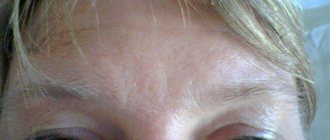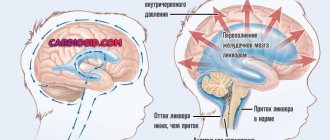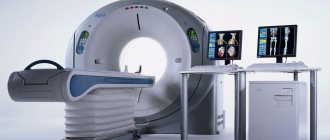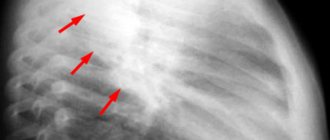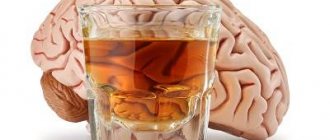Content
- Headache in the back of the head
- Head and eyes hurt
- Headache and fever
- Headache and nausea
- Headache during pregnancy
- Headache in temples
- Headache and dizziness
- Headache while breastfeeding
- Headache MISCELLANEOUS
- Headaches with osteochondrosis
- Blood pressure and headaches
- What can cause a headache?
- Brain cyst
- Nursing mother with headache
- Brain treatment
- Painkillers for headaches
- Brain tumor
- Why does my head hurt?
- Strong headache
- Headache tablets
- Fever and headache
- The child has a headache
- Frequent headaches
- What to do if you have a headache
- Encephalopathy
Other articles:
| What to do if you feel sick from a hangover If after further... |
| Causes and treatment of bloating and abdominal pain Bloating more… |
| What can cause a very bad headache? Strong more... |
You might be interested in:
| My head hurts and feels dizzy after heavy drinking. Many more... |
| Headache and dizziness after massage more... |
| Tension headaches are very common in the modern world... |
Composition and types of plaques
If a person’s blood vessels are soft, elastic, and their tone is normal, then special substances prevent the formation of atherosclerotic plaques. These are wall enzymes designed to dissolve fats that accumulate inside the capillaries. The beginning of the process of formation of pathological tubercles on the walls of arteries involves a combination of negative conditions.
This may be due to poor nutrition with excess animal fats in the diet, damage to the walls of capillaries, which lose their elasticity and become loose. The formation of plaques in blood vessels takes more than one year - first there is an active deposition of cholesterol, only then it becomes overgrown with connective tissue fibers and turns into a pronounced hard tubercle.
A plaque is essentially a core surrounded by a shell consisting of cholesterol and esters. And the environment is a mixture of fats and macrophages, and the fats gradually destroy the macrophages and enter directly into the nucleus. The part of the plaque that protrudes into the lumen of the vessel is a fibrous membrane; it consists of elastin and collagen. The content of these substances determines whether the plaque will rupture or remain intact.
At the stage when the plaque has just begun to form, its structure is semi-liquid, so a particle of the growth can come off, move along the inside of the capillary and completely clog it
At this time, formations can still resolve with adequate treatment, which is why experts advise paying attention to the primary symptoms of atherosclerosis rather than waiting for dangerous complications
As the disease progresses, the growth becomes overgrown with calcium, acquiring an increasingly dense structure. A slowly growing calcified plaque does not allow blood to fully flow to the internal organs and the brain (depending on the location), which causes a deficiency of oxygen and nutrients in the tissues.
If we explain the mechanism of formation of plaques in blood vessels, then the process consists of certain stages:
- Deposition of lipids on the vascular wall.
- Connection to the process of leukocytes, which contribute to the development of an active inflammatory process.
- Penetration of monocytes into the vascular wall with the further release of macrophages with a porous structure.
- The beginning of pathological changes in the state of the internal arterial layer.
- Adhesion of platelets to that part of the wall where the process of damage has already begun.
- The release of protective mediators and an increase in the number of cells - this is the reaction of the immune system to what is happening.
- The production of collagen and elastin, the penetration of their particles into the inner layer (endothelium) lining the vessel.
- Hardening of the plaque and its increase in volume.
Plaques are divided into stable and unstable, and the types depend on the volume of formation and its composition. With a complicated form of atherosclerosis, heterogeneous plaques appear. Unstable formations contain most of the fat, their structure is loose, so such plaques are more likely to rupture against the background of the formation of blood clots and complete blockage of the artery.
Stable ones break much less often, since they consist of collagen fibers, which means they have a more elastic structure. They take much longer to form, so they are easier to dissolve at the initial stage of the disease. Growths in which calcium deposits are high are less dangerous than those with a liquid structure; they do not appear, but it is no longer possible to completely dissolve them.
Atherosclerotic formations can have various manifestations:
- do not manifest themselves in any way, since they increase in volume for many years, do not leave the vascular walls and do not interfere with normal blood flow;
- slowly progress, releasing into the lumen of the artery until it is partially blocked;
- provoke a rupture and cause blood clotting from inside the capillary - if this occurs in the aorta or brain tissue, a heart attack or stroke is inevitable.
Heterogeneous plaques have a loose structure, they have many depressions and tubercles, which is why such formations are often ulcerated.
Treatment methods
Treatment of atherosclerosis should begin in the early stages. It is impossible to completely remove atherosclerotic plaques, but it is possible to reduce their volume and soften the structure. Provided that the patient follows medical recommendations and undergoes all necessary procedures.
General principles
First, you should change your lifestyle - give up bad habits, quit smoking and minimize alcohol consumption. Blockage of blood vessels will not disappear on its own, but to maintain the condition of the blood vessels, it is necessary to engage in physical exercise, spend more time in the fresh air, and reduce body weight.
Without following a diet, the fight against atherosclerotic plaques will be unsuccessful. It is worth giving up foods rich in cholesterol - cocoa, chocolate, animal fats, high-fat milk, offal, eggs. And you should also limit the consumption of baked goods, carbonated drinks, pure sugar and salt.
Set of products allowed for consumption:
- nuts;
- beans, legumes;
- berries;
- cabbage (broccoli, white cabbage, cauliflower, sea cabbage);
- greens - dill, spinach, parsley, celery;
- citrus;
- zucchini and eggplant;
- green tea in unlimited quantities.
These products are rich in Omega 3 acids, iodine and vitamins B, C, A. That is why they are so useful to consume. When the flow of ascorbic acid into the body is established, the vessels restore their tone and are less subject to changes.
Procedures such as general massage, acupuncture, and therapeutic exercises help relieve vascular spasm. You can engage in light sports - swimming, walking, jogging. Against the backdrop of proper nutrition, quitting smoking and alcohol, physical therapy sessions and sports will help significantly improve the patient’s quality of life.
Taking medications
Drug treatment of atherosclerosis is based on taking drugs from the following groups:
- statins - Pravastatin, Atorvastatin, Simvastatin (normalize the amount of cholesterol in the blood, controlling its production by the body itself;
- capillary dilating agents - Pentilline, Pentoxifylline;
- drugs that improve blood circulation - Cilostazol;
- lowering cholesterol levels, in addition to statins - fibrates Ciprofibrate, Clofibrate;
- vitamin complexes – Aevit, Ascorutin, Ascorbic acid;
- derivatives of nicotinic acid.
The dosage, necessary medications, course of administration - all this is determined by the attending physician. Self-medication is dangerous due to the development of side effects and complications, since statins and fibrates can negatively affect liver function if not treated correctly.
Surgical treatment
The operation is indicated in severe cases of atherosclerosis, when the disease threatens the health and life of the patient. Stenting is the operation most often performed for problems with blood vessels. Under the control of an angiograph, a balloon with a stent is inserted into the affected area of the body directly into the artery. With the help of gas, the stenotic vessel expands, then a stent is installed there, which will maintain normal blood circulation and prevent the capillary from narrowing again.
Coronary artery bypass surgery - allows you to resume blood flow impaired by blockage. A bypass path of blood supply is created, avoiding completely blocked vessels. For a shunt, a healthy capillary is taken, for example, from the femoral area. If the plaques have completely blocked the lumens of the arteries in the legs, and the limb is already affected by gangrene, the necrotic part is amputated.
If plaques no longer resolve on their own, even with lifestyle changes and diet, doctors may recommend a type of surgery
Surgical techniques
Surgical treatment of the problem is considered in two cases: with a high risk of blockage and with serious damage to the blood vessels. Removing cholesterol in the form of a lipid layer is a temporary solution, but the operation does not reduce the amount of bad cholesterol.
Vessel stenting
To restore normal blood flow, the following types of operations are used:
- Shunting. Often surgery saves the lives of people who have heart problems. Doctors establish a “bypass” path for blood flow at the site of vessel damage.
- . The procedure is aimed at combating deposits. The cleaning vessel is cut, cleaned, and then sewn together.
- Stent installation. The manipulation allows you to permanently leave the vessel of the required width for normal blood circulation. Stents are installed in places where there is severe narrowing of the vessel.
These types of surgical interventions cannot guarantee a complete reduction in cholesterol levels, as they resolve the issue locally. The patient still needs to monitor his health, nutrition and lifestyle.
Plaque formation
Atherosclerotic (cholesterol) plaques may be called:
- calcined;
- fibrous;
- atheromatous.
Cholesterol plaques in blood vessels are formed due to the accumulation of harmful cholesterol fraction. Due to insufficient production of hormones, the process of cell division in the walls of blood vessels is disrupted. Old sections of cells are most often torn off by the blood flow, which leads to the formation of holes that are filled with platelets.
The integrity of the vessel walls is disrupted, and fat droplets in the protein membrane begin to reach the platelets. This leads to the accumulation of harmful cholesterol on the vascular walls. Over time, the formations begin to destroy the neighboring vascular cells, and in parallel, calcium accumulates.
Gradually, the movement of blood becomes more difficult, and the cholesterol plaque increases in size. A large concentration of them appears on the surface of the skin in the form of bluish tubercles. There are sometimes more than 10 of them on the body. Symptoms vary depending on where the cholesterol plaques form.
In this case, you can easily identify the area in need of research. With atherosclerosis of the heart vessels, the symptoms are similar to those of a heart attack; atherosclerosis of the carotid artery manifests itself:
- sudden numbness;
- weakness in the lower limbs and arms;
- slurred speech;
- drooping of the facial muscles.
With atherosclerosis of the limbs, the patient suffers from severe pain that occurs during movement. Before proceeding with additional studies, the specialist seeks to assess the need for them based on the following symptoms, which are recognized during the examination:
- In the lower part of the narrowing of the arteries, the pulse is absent or weak.
- Low blood pressure is observed in the affected limbs.
- With a stethoscope, noises emanating from the area of narrowing of the arteries are heard.
- Heavy eyelids, dark circles under the eyes.
- Long period of wound healing in places where blood flow is restricted.
If there are cholesterol plaques in the vessels of the legs, then the patient will constantly experience burning pain in the calves
How does the presence of plaques affect the patient’s face?
A person can understand that he has plaques in his blood vessels by looking at his face. Most often they can be seen before the eyes. These plaques are called xanthelasmas, and they are usually located on the inner corner of the upper eyelid. If you do not pay attention to them, the plaque may increase, and another xanthelasma will appear next to it.
A person who has xanthelasma must remember that this defect is a direct symptom of the presence of plaques in the body. Some doctors suggest removing this lump, but without treating the body and cleaning the blood vessels, this procedure does not bring any benefit. Xanthelasma appears again, and a small scar forms at the site of its removal.
How the problem manifests itself
If the body is affected by atherosclerosis, then the accumulation of cholesterol will be observed in almost all arteries and vessels. But the manifestations are more often local and depend on the location of the stenotic artery - such symptoms are shown in the photo and posted on websites dedicated to atherosclerosis.
Since many years may pass from the onset of the development of pathology to the appearance of severe symptoms, you need to be aware of the primary signs of atherosclerosis: the appearance of weakness that is not associated with excessive stress and fatigue, a feeling as if “goosebumps are running along the leg, arm or thoracic region,” sudden in a stupor, a feeling of numbness, disturbing on one side of the body - in the arm or leg.
All manifestations of the presence of cholesterol plaques in blood vessels come down to a slowdown in blood flow in the affected area, lack of nutrients and oxygen
Visual impairment also occurs in one eye, the second, as a rule, sees well, and problems with speech and memory - the person becomes forgetful, confuses dates and events, and begins to speak inarticulately. If the formations constantly increase in volume and interfere with the full blood supply to the organ, then pain will be present in this part of the body.
The skin becomes numb, and a constant tingling sensation appears. The symptoms listed above are observed if the plaque has disintegrated and its particles move along the bloodstream. Here, the risk of cerebral hemorrhage and heart attack increases significantly.
Plaques in the thoracic aorta
The main symptoms of cholesterol deposits in the thoracic region are sharp nagging pains near the heart. They radiate towards the neck, shoulder blade, shoulder girdle and upper limb, and the discomfort cannot be relieved by taking Nitroglycerin.
Severe symptoms appear: pain in the head, pallor or bluishness of the skin on the face, decreased performance, a constant feeling of fatigue, problems with reproducing recent events, forgetfulness and inattention, convulsions, fainting or clouding of consciousness. During the period of exacerbation of thoracic atherosclerosis, the patient's blood pressure rises, he complains of shortness of breath and other symptoms of ischemia.
Damage to the blood vessels of the head
If the vessels of the brain are affected by atherosclerosis, then we are talking about the deposition of cholesterol plaques in the CCA (common carotid artery), subclavian and the mouth of the ICA (internal carotid artery). They nourish the brain tissue, therefore, the disease manifests itself in a number of negative disorders:
- decline in performance;
- fatigue and constant fatigue;
- memory losses;
- tendency to depression;
- the appearance of unreasonable fears and worsening anxiety;
- disruptions in visual and auditory functions;
- bleeding in the brain with typical consequences - failure of one of the body parts, neurological disorders, loss of speech or motor function.
Blockage of the paravertebral, subclavian and carotid arteries appears gradually. In the initial stages, a person becomes inattentive, gets tired quickly, and cannot cope with the usual amount of work. Next comes a depressive state, which is not justified.
In the last stages of the disease, when the brain is practically not supplied with oxygen and blood, the patient is lost in space, does not remember events, and acquires signs of dementia. The case may result in a stroke with all the ensuing consequences, including disability or death.
In the peritoneal area
When the abdominal artery is blocked, atherosclerosis manifests itself in a number of symptoms:
- lack of appetite, sudden weight loss;
- aching pain around the navel;
- constant bloating, problems with bowel movements;
- feeling of coldness and numbness in the legs;
- swelling of the tissues of the lower extremities.
In the later stages, intermittent claudication occurs - a person’s leg seems to fail, and as a result, he or she limps when moving.
Atherosclerosis of the lower extremities
The disease remains asymptomatic for many years. In the second and later stages, a person begins to notice constant fatigue in the legs, even in the absence of significant physical activity.
The last stages of the pathology are characterized by hair loss on the skin of the legs in the shin area, the appearance of trophic ulcers and ulcers. The toes may turn red and take on a dark tint, this is due to a lack of blood supply and the gradual death of cells.
Causes
The main source of development of atherosclerosis of the vascular system is the presence of high cholesterol levels.
The deposition of plaques on the walls of the bloodstream begins with the accumulation of lipid fatty spots. Constantly collecting free particles, they grow and combine into a plaque. When disintegrating, they circulate through capillaries, veins, arteries, clogging narrow gaps.
The structure of cholesterol is capable of accumulating calcium salts, due to which it begins to increase in volume, disrupting the normal movement of blood.
The formation of fat accumulation is associated with internal factors:
- Disorder of the functioning of the channel walls;
- Penetration of lipoproteins into the vascular structure, establishment of interaction with native cells;
- Autoimmune disorders;
- Intoxication processes from the activity of parasites and protozoa;
- Malfunctions of the endocrine system;
- Hypertension;
- Hereditary predisposition.
Also at risk are people belonging to categories with:
- An unhealthy lifestyle, especially smoking, has a detrimental effect on the structure of the vessel;
- Obesity III and IV degrees;
- High sugar, diabetes;
- Tendency to overeat;
- Lack of a balanced diet;
- Post menopause;
- tendency to thrombosis;
- Let's limit physical activity.
If you suspect atherosclerotic changes, you should seek help from a specialist.
Prevention methods
Is it possible to prevent the development of plaques and how to clean blood vessels from plaques in the initial stages of the disease? Preventive recommendations from doctors for those people who monitor their health will help answer this question.
So, in order to protect yourself from the development of plaques in the blood vessels, it is important to adhere to proper nutrition throughout your life. Here are the basic principles of healthy eating for an adult:. A person should reduce the consumption of animal fats as much as possible
Every day you need to eat foods that are rich in protein. You need to eat often, but the portions should be small. You need to consume fermented milk products every day. Most of the diet should consist of plant foods
A person should reduce the consumption of animal fats as much as possible. Every day you need to eat foods that are rich in protein. You need to eat often, but the portions should be small. You need to consume fermented milk products every day. Most of the diet should consist of plant foods.
However, some people are too fanatical about diet and begin to exclude any fatty foods. This is not recommended, because in addition to bad cholesterol, there is also good cholesterol. Good cholesterol is found in vegetable oils, as well as in fatty fish.
Cleansing blood vessels with nutrition and medications
In order to remove cholesterol accumulated over many years and get rid of plaques in the blood vessels of the brain, it is necessary to use complex therapy . In addition to treatment with medications, it is necessary to adhere to a healthy lifestyle and avoid junk food. Your daily diet should consist of plenty of fresh vegetables and fruits, a small amount of nuts and lean fish or meat. It’s better not to get carried away with eggs, especially fried ones; it’s enough to eat a couple of boiled eggs a week, and choose milk and sour cream with a minimum amount of fat.
People prone to atherosclerosis need to give up margarine and cheap low-quality vegetable oil, replacing it with olive oil, grape seed oil or some other oil. It is also recommended to include legumes in your diet: beans, peas, lentils. Food should always be fresh and consumed regularly, in small portions. The amount of water you drink also plays an important role in maintaining health. Doctors recommend drinking at least 2 liters of plain, clean water per day.
Also, drinking herbal tea, beet kvass or cabbage juice can have a beneficial effect on cleaning blood vessels. Drug treatment involves taking special medications that will help lower blood pressure and remove cholesterol deposits from the body. Such drugs should be prescribed only by a qualified specialist after the patient has passed all the necessary tests.
When treating atherosclerosis, it is necessary to consume large amounts of almost all vitamins. Leech treatment or therapeutic exercises may also be used to lower blood pressure. In extreme cases, when the disease process is advanced, surgical intervention may be necessary. But to avoid this, you need to regularly clean clogged vessels, both with medication and with the help of folk remedies.
Causes of pathological deposits in blood vessels
The formation of cholesterol accumulations in loans can take years, and the patient does not even realize that he is sick, attributing the symptoms to other reasons (fatigue, stress, overload of the body). The main factors that provoke deposits of harmful substances in the capillaries are considered to be poor nutrition and heredity.
But there are other reasons why atherosclerotic disease develops:
- Age category - until the age of 50, signs of the disease appear partially, while the body has the ability to independently cleanse itself of harmful substances and maintain vascular tone. After 50 years, capillaries become weak and brittle, and cholesterol tubercles significantly damage their condition, leading to clear manifestations of atherosclerosis.
- Gender – it has been proven that women develop atherosclerosis several times less often than men due to the support of normal vascular tone by the hormone estrogen. But after 50 years, the chances of getting sick in both sexes become equal, since women begin menopause, and the capillaries become less elastic and undergo pathological changes.
- Heredity - scientists have found that lipid metabolism disorders in the body are the result of gene pathologies transmitted from generation to generation. Therefore, one should not be surprised at a person who suffers from atherosclerosis if several people in his family suffered from this pathology.
- A high amount of cholesterol in the blood plasma - this factor leads to the accumulation of a “bad” type of substance on the walls of blood vessels, their narrowing and cessation of normal blood circulation to organs and tissues.
- High blood pressure – in people who have problems with blood pressure surges, cholesterol deposits occur much faster. The blood vessels are already narrowed due to constant spasm, and lipid metabolism disorders only aggravate the situation.
- Addictions - as a result of the constant entry into the blood of pathogenic substances (carcinogens, mutagens, resins, ethyl alcohol), the vessels narrow and cannot independently control the tone. And the accumulation of cholesterol further complicates the situation, causing atherosclerosis with stenosis of the arteries.
- Concomitant diseases - according to doctors, in patients with diabetes and disruptions in the endocrine system, the accumulation of cholesterol in the blood occurs faster. And atherosclerosis itself manifests itself brighter and more aggressively.
Excess body weight is another reason why atherosclerosis progresses rapidly.
Obese people almost always have problems with blood pressure, they move little and eat poorly. It turns out to be a vicious circle, the way out of which is to reduce body weight, follow a diet, physical activity and timely initiation of treatment for atherosclerosis. Obese patients should take therapeutic measures immediately, while it is possible to reduce the density and volume of plaques.
And it has also been proven that being in a constant state of stress or depression negatively affects the structure of arteries throughout the body. In a dangerous situation, the adrenal cortex secretes a large amount of hormones that provoke vasospasm. Therefore, signs of atherosclerosis, if any, will appear more aggressively in people with an unstable emotional background.
Diet
The success and productivity of atherosclerosis treatment directly depends on diet. Most often, people who are overweight are susceptible to this disease. To avoid complications of the disease and speed up recovery, you need to make a diet your lifestyle eating style.
Foods high in cholesterol should be excluded from the diet:
- Fatty meat and fish;
- Alcoholic drinks;
- Chocolate, cakes, baked goods, cocoa;
- Fatty rich soups and broths;
- Liver, brains, kidneys;
- All types of lard and animal fat;
- Spicy, salty dishes;
- Coffee, strong black tea.
Instead of animal fats, you can use liquid fats of vegetable origin. Oils containing polyunsaturated fatty acids of the Omega group are especially useful: Omega-3, Omega-6, Omega-9. Flaxseed and olive oils are rich in them. Despite their high calorie content, these products help cleanse and strengthen blood vessels, restore their elasticity, and normalize metabolic processes.
Why do cholesterol plaques appear in blood vessels?
Atherosclerotic plaques tend to form in people with high blood cholesterol levels. When examined, they appear as deposits consisting of calcium, fat and tissue. Of course, plaques in blood vessels do not form immediately. At first, their rudiments look like fatty stripes on the walls.
Plaques are very dangerous for the human body. They have a heterogeneous density, which makes them more likely to break off and clog blood vessels. The separated part is already called a thrombus. The stuck blood clot enlarges over time and completely blocks the blood flow.
People who often drink alcohol or eat fatty and fried foods should also monitor the presence of plaques in the body. There is a high probability of cholesterol deposits in older people, as well as those who suffer from diabetes and excess body weight.
Methods for diagnosing cervical plaques
Of course, it is better to prevent a disease than to treat it, but it is very easy to miss the development of plaques in the body. As mentioned above, the disease does not manifest itself for a long time and the person does not feel any symptoms.
To understand that a person really suffers from such an ailment as plaques on the walls of the vessels of the neck, the doctor must prescribe the appropriate diagnosis. Now almost all clinics are equipped with the necessary modern equipment, so the examination should not be difficult for either the doctor or the patient, however, many procedures are provided only on a paid basis.
The most informative methods that detect the presence of plaques in the cervical spine are MRI (magnetic resonance imaging) and vascular ultrasound. But there are some nuances here too. The fact is that in half of the cases, blockage of blood vessels by atherosclerotic plaques can only be detected if the lumen has been completely closed and the disease has already entered an advanced state.
Because of this, doctors strongly recommend monitoring your diet, lifestyle and giving up bad habits as quickly as possible, because sometimes doctors simply cannot provide proper assistance on time.
Symptoms
Plaques in the vessels of the head interfere with normal blood circulation in the brain and cause disorders in its functioning.
This affects the general condition and is expressed by the following symptoms:
- headaches of varying intensity, both constant and periodic;
- hearing impairment;
- insomnia, nightmares, difficult awakening, daytime sleepiness;
- memory impairment;
- dizziness;
- speech disorders;
- nervous tension, anxiety, increased excitability;
- decreased performance, chronic fatigue.
The nature of the symptoms depends on the stage of development of atherosclerosis and on the size of the plaques in the vessels of the head. The primary manifestations of atherosclerosis are dizziness, tinnitus, mild malaise and fatigue, felt mainly in the afternoon and evening. Such signs are mild and disappear after sleep and rest. You also feel better after a walk in the fresh air, which helps improve the supply of oxygen to the brain. That is why rarely do any patients consult a doctor at an early stage of pathology progression.
As the disease progresses, the symptoms described above become more alarming. Patients begin to experience trembling in the limbs, an unsteady gait, and a lack of coordination and functioning of the vestibular apparatus. Speech problems arise. There may be a sore sensation while eating. People with this disease become overly irritable and suspicious.
At the stage of decompensation
the condition of the patients sharply worsens, memory weakens and is partially lost, mental activity and thinking abilities are disrupted. People cannot take care of themselves and need constant care. At this stage, the risk of sudden stroke and paralysis increases significantly.
The shortest stage of atherosclerosis is a transient ischemic attack.
, the signs of which are characteristic of a microstroke. Speech problems arise, sensitivity in the limbs is lost.
The condition becomes more complicated and due to the fact that plaques in the vessels of the head completely block the lumen, an ischemic stroke develops. As a result of oxygen starvation, necrosis of brain cells begins. Symptoms: severe dizziness, impaired swallowing function, loss of sensation in the arms and legs.
Symptoms of cervical vasoconstriction
It goes without saying that the vessels in the cervical spine are the only source of oxygen for the brain. Their blockage is distinguished by the most striking symptoms. The interesting thing is that in this case, the human brain itself is first affected.
Atherosclerotic plaques in the vessels of the neck cause the following symptoms:
- frequent dizziness;
- heaviness in the head and neck;
- loss of strength and weakness;
- memory loss.
It is worth noting the danger of this disease. Symptoms of plaques in the cervical spine are often mild. A person only pays attention to the pain at first, but then gets used to it and does not see a doctor for a long time.
Plaques and blood clots are dangerous not because of their symptoms, but because of their ability to completely block blood vessels. Sometimes a blood clot gets into a very important vessel, and then a person’s life will be at great risk.
Experienced doctors note that recently most strokes are provoked by plaques. A stroke, in turn, has very dangerous consequences. If a person is not provided with timely medical assistance, then his recovery may take a long time, and full recovery is out of the question.
Consequences
Late detection of atherosclerotic changes in the brain leads to severe complications.
The most favorable prognosis, if all treatment recommendations are followed, is expected if deposits in the vasculature grow up to a certain point, then reduce their activity. In this case, the symptoms manifest themselves weakly, leading to an unexpressed pathology of the blood flow system.
Serious pathological changes in the central nervous system occur when the lumen of the bloodstream is filled with plaques by more than fifty percent. In brain activity, acute consequences are found in the form of:
- Transient attacks - necrosis of cerebral tissue;
- Stroke of ischemic (hypoxia) or hemorrhagic (rupture of a blocked vessel) types.
The most severe outcome occurs when a cholesterol clot ruptures, which provokes dyscirculatory encephalopathy and cerebral infarction.
Atherosclerotic damage to the blood vessels and canals of the cerebral sections in all cases leads to serious pathologies; untimely, inadequate treatment threatens a person with disability and death.
Author of the article: Neurologist of the highest category Tatyana Mikhailovna Shenyuk.
Treatment of cerebral atherosclerosis
The treatment regimen for atherosclerosis is a long, and most often lifelong, process. In this regard, the goals of therapy are:
- reduction of ischemic manifestations;
- restoration of some cells and their functions;
- preventing severe consequences of stroke;
- changing fat metabolism to remove “bad” cholesterol.
A neurologist is responsible for solving these problems; his responsibilities include identifying people with similar problems, assessing the severity of the disease and implementing conservative therapy. First of all, it is designed to improve blood supply to the brain and prevent arterial thrombosis.
Causes of atherosclerosis
There are various theories to explain the formation of plaques. According to one of them, the trigger is a slowdown in blood flow due to a physical obstruction, for example, a branching artery or arteriole. Lipids enter the lining of the vessel from its lumen - they penetrate along with the blood plasma. The process is accelerated by hypertension and oxygen starvation (hypoxia).
First, fibrosis occurs - the replacement of normal tissue in the artery wall with connective tissue. During this period, the plaque is still soft. Parts of the seal in the first stages can be torn off by the blood flow, migrate through the vessels, and settle in the narrowest places. Inflammation promotes further accumulation of cholesterol and calcium.
How plaque formation affects the blood supply to organs:
- As a result of the inflammatory process, the inner wall of the vessel thickens.
- Accumulations of cholesterol, calcium, and proliferation of connective tissue narrow blood flow.
- Tissues and organs are not sufficiently supplied with oxygen and essential nutrients.
- When atherosclerotic plaques are destroyed, blood clots form, which can completely block the lumen of small vessels.
There are other descriptions of the mechanism of development of atherosclerosis and the formation of plaques in blood vessels. For example, the hypothesis of the influence of “bad” cholesterol, which transports lipids from the liver to cells throughout the body. This fat can accumulate on the inner walls of the arteries. The inflammatory process develops, leukocytes migrate and further absorption of lipids occurs. A “fatty stripe” is formed in the vascular wall—the “foundation” of an atherosclerotic plaque.
All the conditions that influence the occurrence of vascular pathology are still unknown. Under the influence of various factors, which often act together, metabolism is disrupted. It has been established that there is a genetic predisposition to the development of an inflammatory process in the vascular wall. Heart attacks and strokes often affect close relatives.
Reasons why plaques form in blood vessels:
- a combination of high levels of “bad” cholesterol and obesity;
- lack of physical activity (physical inactivity);
- high blood pressure;
- unfavorable heredity;
- excess animal fats in food;
- lipid metabolism disorders;
- smoking, including passive smoking;
- alcohol abuse;
- diabetes;
- intoxication.
According to one theory, the inner wall of the vessel becomes inflamed due to exposure to toxins from bacteria, viruses and the immune response. Atherosclerosis often develops against the background of other diseases, such as hyperthyroidism, gout, and autoimmune processes.
Complications
Complications after endarterectomy usually develop in individuals at risk:
- Aged people,
- Smoking,
- Weakened and seriously ill,
- Having plaques in other vessels,
- Having previously undergone a similar operation,
- Suffering from severe somatic diseases, oncopathology, endocrinopathy.
Complications that occur during endarterectomy include: stroke, bleeding, cardiac complications, restenosis, damage to the neurovascular bundles of the neck and cranial nerves, infection, thrombosis, allergies to anesthesia, damage to the lymphatic vessels and salivary glands, recurrence.
Endarterectomy is an effective procedure that restores blood flow through vessels affected by atherosclerosis. This is a fairly common operation that many specialists resort to. But not every patient is able to pay for this service. The average cost of an operation in commercial clinics in Moscow will cost patients 70 thousand rubles. In most public clinics, this operation is performed free of charge as part of compulsory medical insurance or at the expense of a quota from the Ministry of Health of the Russian Federation.
It should be remembered that surgical treatment will help the patient get rid of the pathology much faster than conservative treatment. Today in Russia there are no drugs that completely cure atherosclerosis and its manifestations - stroke or. During surgery, surgeons not only remove atherosclerotic plaques, they save patients from premature death, reducing the risk of stroke or heart attack.
Symptoms of atherosclerosis
Symptoms of cerebral atherosclerosis are very diverse. Not all of them may appear immediately. Clinical manifestations may increase gradually, and new symptoms may appear over time, as the growth and number of atherosclerotic plaques occurs gradually.
The following clinical manifestations are characteristic:
- Headache of varying intensity and duration, tinnitus
- Sleep disorders - difficulty falling asleep, frequent awakenings at night, nightmares, drowsiness during daylight hours
- Exacerbation of character traits, sometimes reaching the point of absurdity
- Excessive anxiety, suspicion, excitability
- Fatigue, decreased performance
- Memory loss, dizziness
- Loss of coordination, slowness of movements
- Blurred speech, choking when eating
Stage of initial manifestations. As a rule, at first a person experiences only periodic symptoms (after overwork, being in an unventilated room), such as dizziness, tinnitus, headaches, decreased memory and performance. Symptoms are especially intensified in the 2nd half of the day, and after rest the state of health improves.
Stage of progression. Then the first signs of atherosclerosis intensify and are added from time to time by trembling of the hands, depression, unsteadiness of gait, speech deteriorates, suspiciousness appears, and choking while eating. A person begins to overestimate his abilities and strengths, and if he fails, he blames others.
Stage of decompensation. As the disease progresses, a stage of decompensation occurs, when a person significantly loses memory, needs outside help, since thinking abilities deteriorate, difficulties arise with self-care, and in this condition there is a high risk of developing stroke and paralysis.
A transient ischemic attack is a short-term condition that resembles a stroke, but passes quickly (within a day). The symptoms of such an attack depend on the location of the affected area of the artery, for example, legs and arms become unruly, numbness of the tongue, problems with pronouncing individual words (see signs of a micro-stroke). Ischemic stroke - with obliteration (complete cessation of blood flow due to blockage of an atherosclerotic plaque) of the arteries brain, an ischemic stroke occurs, that is, the death of brain cells due to lack of oxygen and nutrition. Depending on which vessel is blocked by the plaque, there may be various clinical manifestations (see the first signs of stroke in women):
- Weakness or complete absence of voluntary movements in the limbs
- Decreased or absent sensation in the limbs
- Speech Impairment
- Severe dizziness and loss of coordination
- Swallowing disorder
Hemorrhagic stroke occurs less frequently than ischemic stroke (approximately 30% of all stroke cases), and it develops very rapidly. The difference between such a stroke is that, against the background of oxygen starvation, a hemorrhage occurs in the white or gray matter of the brain, and not a blockage of the artery. Moreover, it is quite difficult to determine from the symptoms what type of stroke occurred, and first aid and treatment are fundamentally different.
Signs
Certain signs of cerebral atherosclerosis include the following symptomatic picture:
- Insomnia, nightmares at night, difficulty getting up and problems falling asleep again;
- Loss of sensation in half of the body;
- Severe, frequently recurring headaches;
- Change in gait, steps are uncertain and shaky;
- Changes in speech, vision, tinnitus;
- Irritation, depression, tearfulness and anxiety;
- Hot flashes and sweating of the face;
- Fatigue, weakness and absent-mindedness;
- Trembling of the chin and limbs;
- Memory problems;
- Facial asymmetry.
The above signs are not yet a diagnosis. To confirm or refute atherosclerosis, you need to contact a neurologist, or at least check your cholesterol level by taking the appropriate test.
How to help blood vessels using traditional medicine
Bay leaf is a folk medicine that came to us from our ancestors. Its unique property is its ability to destroy plaques in a short time and strengthen the immune system. To do this, you need to weigh 7 g of dry leaves and pour 2 cups of boiling water over them, let them simmer for 5 minutes over low heat. Place the mixture in a dark place to infuse. After a few hours, strain the broth and consume it a little three days after meals.
Lemon and garlic have long been considered the most popular folk remedies. Due to the high content of vitamin C in lemon, it helps cleanse blood vessels of cholesterol and strengthen their walls, but regular consumption of fresh garlic will be an excellent preventive measure against the formation of plaques.
It is best to start treatment with these products in the autumn-winter period, when there is young garlic and lemon will help protect against seasonal viral diseases. You need to prepare freshly squeezed juice from 1 kg of lemon and mix with 1 glass of garlic porridge, squeezed through a garlic press.
Mix the resulting mixture well and place in a cool, dark place for 3 days. Before use, mix 1 tsp. mixture with water and take at least 1 time per day. You can also take 200 g of garlic, 1 onion and 3 lemons. Grind all this using a meat grinder and add 1 glass of liquid honey, mix. The course of administration is 1 tsp several times a day before meals.
Treatment with vegetable and fruit juices is considered the most delicious and healthy. Pomegranate juice has long been called the leader in cleaning blood vessels. Its regular use will help not only cope with existing cholesterol deposits, but also prevent the formation of new plaques. You can also mix freshly squeezed carrot and potato juices in equal quantities (no more than 300 ml), add beetroot juice (about half a liter) and mix thoroughly. Drink half a glass of the mixture before meals several times a day.
You should not engage in your own treatment or its prevention without consulting a doctor. Only a specialist, when confirming the diagnosis, will help draw up the correct treatment regimen and select medications or traditional recipes.



